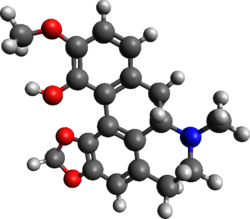Biology:Bulbocapnine
 | |
 | |
| Clinical data | |
|---|---|
| Other names | Bulbokaprin |
| Identifiers | |
| |
| CAS Number | |
| PubChem CID | |
| ChemSpider | |
| UNII | |
| KEGG | |
| ChEBI | |
| ChEMBL | |
| Chemical and physical data | |
| Formula | C19H19NO4 |
| Molar mass | 325.364 g·mol−1 |
| 3D model (JSmol) | |
| Melting point | 201 to 203 °C (394 to 397 °F) Racemate 213-214 °C |
| |
| |
Bulbocapnine is an alkaloid found in Corydalis (notably the European species C. cava) and Dicentra, genera of the plant family Fumariaceae which have caused (notably the American species Corydalis caseana) the fatal poisoning of sheep and cattle.[1] It has been shown to act as an acetylcholinesterase inhibitor,[2] and inhibits biosynthesis of dopamine via inhibition of the enzyme tyrosine hydroxylase.[3][4] Like apomorphine, it is reported to be an inhibitor of amyloid beta protein (Aβ) fiber formation, whose presence is a hallmark of Alzheimer's disease (AD). Bulbocapnine is thus a potential therapeutic under the amyloid hypothesis.[5] According to the Dorlands Medical Dictionary, it "inhibits the reflex and motor activities of striated muscle. It has been used in the treatment of muscular tremors and vestibular nystagmus".[6]
A psychiatrist at Tulane University named Robert Heath carried out experiments on prisoners at the Louisiana State Penitentiary using bulbocapnine to induce stupor.[7] This work at Tulane inspired, and was continued parallel to, experiments carried out at the behest of the Central Intelligence Agency. The bulbocapnine work Heath conducted for the government was one component of a large investigation into the potential of psychoactive compounds as aids to interrogation.[8]
Effects
It can induce catalepsy featuring the curious symptom of waxy flexibility[9] and the state produced by the drug has been compared to Akinetic mutism.[10][11]
In popular culture
In literature
- The author William S. Burroughs references the drug in his book Naked Lunch (1959), in which the fictional Dr. Benway uses it to induce obedience in torture victims.
In television
- The drug's use to treat Mayor Kane's father-in-law and predecessor is a plot point in season 2 of the TV series Boss, e.g., in episodes s2.e8 ("Consequences"; October 5, 2012) and s2.e9 ("Church"; October 12, 2012).
See also
References
- ↑ CRC World Dictionary of Medicinal and Poisonous Plants: Common Names ... p.1142.
- ↑ "Acetylcholinesterase and butyrylcholinesterase inhibitory compounds from Corydalis cava Schweigg. & Kort". Journal of Ethnopharmacology 113 (1): 179–182. August 2007. doi:10.1016/j.jep.2007.05.006. PMID 17574358.
- ↑ "Inhibition of tyrosine hydroxylase by bulbocapnine". Planta Medica 63 (4): 362–363. August 1997. doi:10.1055/s-2006-957702. PMID 9270381.
- ↑ "Inhibitory effects of bulbocapnine on dopamine biosynthesis in PC12 cells". Neuroscience Letters 244 (3): 161–164. March 1998. doi:10.1016/s0304-3940(98)00148-7. PMID 9593514.
- ↑ "New class of inhibitors of amyloid-beta fibril formation. Implications for the mechanism of pathogenesis in Alzheimer's disease". The Journal of Biological Chemistry 277 (45): 42881–42890. November 2002. doi:10.1074/jbc.M206593200. PMID 12167652.
- ↑ "Dorlands Medical Dictionary at Merck". http://www.mercksource.com/pp/us/cns/cns_hl_dorlands.jspzQzpgzEzzSzppdocszSzuszSzcommonzSzdorlandszSzdorlandzSzdmd_b_26zPzhtm.
- ↑ The Mind Manipulators: A non-fiction Account. New York: Paddington Press. 1978. pp. 314–315. ISBN 0-448-22977-3.
- ↑ "CIA Revelations: Behavior Control". ABC News. Radio TV Reports. 20 July 1977. https://www.cia.gov/library/readingroom/docs/CIA-RDP99-00498R000100100019-3.pdf.
- ↑ "Studies on the central effects of bulbocapnine". Psychopharmacologia 22 (3): 234–249. September 1971. doi:10.1007/BF00401786. PMID 5316197.
- ↑ "Stupor and akinetic mutism". Contemporary Neurology. 1984. pp. 96–102. doi:10.1016/B978-0-407-00308-8.50018-5. ISBN 978-0-407-00308-8. https://books.google.com/books?id=yJujAgAAQBAJ&pg=PA96.
- ↑ Experimental catatonia, a general reaction-form of the central nervous system and its implications for human pathology. The Williams & Wilkins Company. 1945. p. 6. OCLC 989851203.
 |

